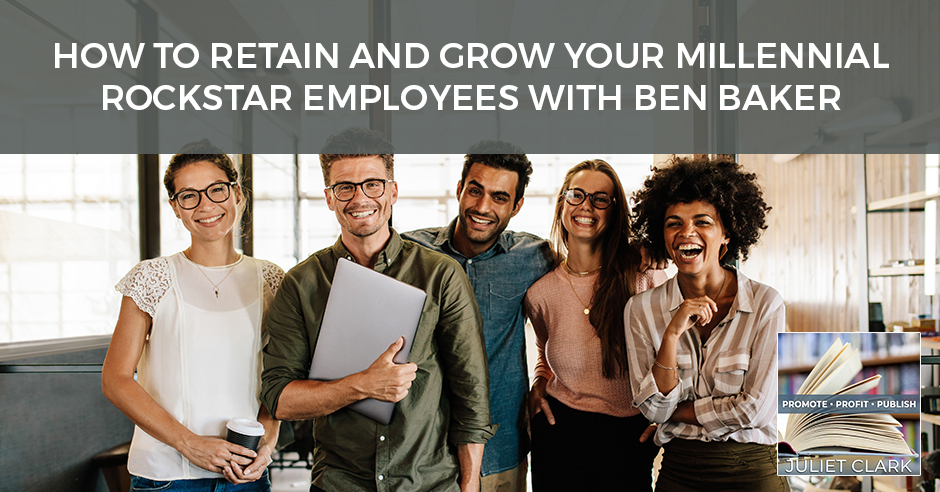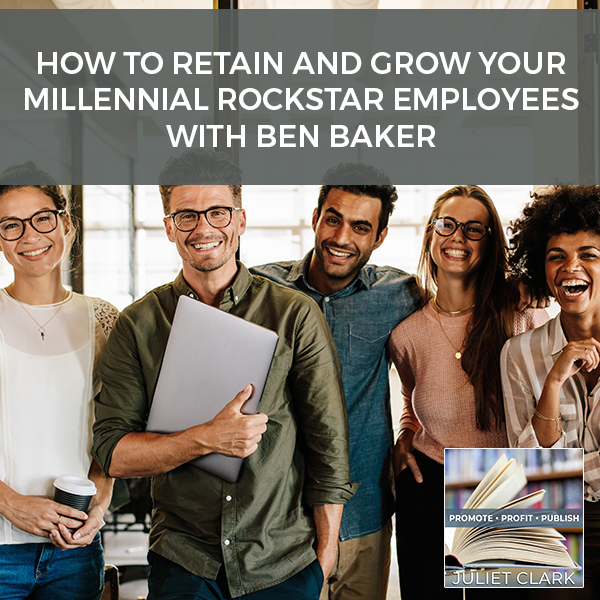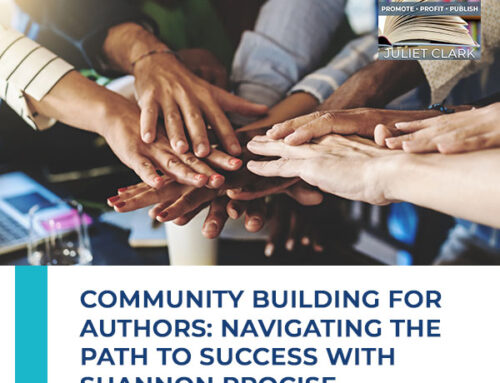
—
Watch the episode here:
Listen to the podcast here:
How To Retain And Grow Your Millennial Rockstar Employees with Ben Baker
We have a great guest and we’re going to discuss something a little bit different. Before we get into it, I want to talk about the Promote Profit Publish Quiz. For those of you who are not sure if your platform is built right, if you’re contacting your consumers in the correct way, if you even know who your consumer is and maybe you’re struggling a little bit, I invite you to go over and take this quiz. Find out where your skill set is. You can find it at www.PromoteProfitPublishQuiz.com. We’re going to do something a little different. Most of the time we talk about speaking and coaching and things like that, but now we’re hiring the next generation of the workforce. I’m hearing from a lot of you that you’re struggling a lot with this. We have Ben Baker on. He’s the Chief Storyteller at Your Brand Marketing. He works with clients to help them retain and grow their Millennial rock star employees. Ben is the author of Powerful Personal Brands: A Hands-On Guide to Understanding Yours. He’s the host of iHeartRadio-syndicated The YourLIVINGBrand.live Show and the Chief Facilitator at Lead At Any Level Workshop series. Storytelling has always been a way of life for Ben. Is that a good thing or a bad thing? What kind of stories were you telling, Ben?
My mother would tell you a different story than I will.
I’m a storyteller too. I always used to be the one that could get us out of situations with the cops when I was a teenager. From a young age, he realized that through storytelling people listen to him, understood him, and engaged. Professionally, this is what he’s been doing now for over two decades. Welcome, Ben.
Thanks a lot. Thank you very much for having me on your show. I appreciate it.
Before we get into the questions about Millennials, tell us a little bit about what your mother would say about your storytelling.
That’s a different story altogether. I grew up in an interesting house. I grew up with an entrepreneurial father and a lot of friends of his were also entrepreneurs. I got that ability to tell stories, the ability to engage, the ability to sell from a very early age. I don’t know if everybody remembers the Tommy Vu of the 1980s. They were people who were like, “You too can make $1 million with no money down. You’ll have houses, cars and good-looking girls on both arms.” Tommy Vu made no money in the real estate industry as far as I know. He made all his money in the seminar game. Two of his best pitchmen, the guys that came into your city and got you to take the $10,000 course, these are the guys that packed you in for free for the half-day seminar those days. They got you all excited and got you to sign for the $10,000 course. Those were two of my dad’s best friends.
Those are the people from the time I was eight or nine years old that I was hanging around. I was learning from them that you always need to have a story in your back pocket. You always need to have just that one more story that you can tell and illustrate a point and be able to get people on your side. If you tell them a story, there’s something that’s going to engage. My mother would say, “You’re telling stories again.” I will go, “I absolutely am.” When you’re eight or nine years old, the stories might’ve been fabricated. They might’ve been stretched a little bit. You didn’t know that you weren’t supposed to stretch or fabricate them. As you get older, those stories get tighter, they become more authentic and they become more real. You have the tapestry to be able to tell more and more stories that are authentic to your life. That’s where my book comes in. It’s a set of stories. It’s the lessons that I learned from them and pokes and prods for people to sit there and say, “How do you build your own personal brand?”
We’re going to talk about the Millennial workforce and the other generations around them because so many people and so many companies are struggling with how do they retain these employees. Why is this age group so misunderstood?
The first thing I want to ask every single person that is either a Gen X or a Boomer is to think back to the point in time when you were sixteen to eighteen years old. We all knew everything. We were all impetuous. We were excited to start our lives. We couldn’t wait to get going. We always thought the generation above us knew nothing and that we knew better. What you see from the Millennial and Gen X generation is the same thing that happened to us. It’s the same thing that happened to our parents. It’s the same thing that happened to our grandparents. The guys in the zoot suits were seen as young, impetuous and rabble-rousers. Those people that are 80 and 90 years old look back to that point in time and says, “Look how wonderful I was.” With age, we all forget how impetuous our time was of our youth and how we wanted everything now that we wanted everything better. The problem with social media is everything is amplified.
When these people look at their feeds and it’s the algorithms of any social media platform, I don’t care if you’re on Snapchat, LinkedIn, Twitter, Facebook, the algorithms say, “Whatever you look at, whatever you’re paying attention to, whatever you’re reading, we’re going to give you more of it.” If all of a sudden you’re looking at feeds of people that are 30 under 30, they are young, they are successful, they are vice presidents of their company, they are making $500,000 a year, that’s what you’re going to start seeing showing up in your feed. It gives people a huge inferiority complex. People sit there and say, “Why them and not us? I’ve got my MBA and they’ve got their MBA. I went to school and they went to school. How come they’re making more money than I am? How come they got that promotion and I didn’t?” Everybody is going, “Why them and not me?” Because of that, people start sitting there going, “I’m 25 years old. If I’m not the vice president of whatever, if I’m not making X amount of dollars, if I don’t have this car, if I don’t have this house, I’m a failure.” They’re not. They’re 25 years old and they have their entire life ahead of them.
People first, purpose second, and then profit third. Share on XIt’s a matter of getting people to understand both from their manager’s point of view that these are the thoughts that are going through their heads. Getting that generation, whether it’s the Millennials or Gen X, behind them to understand that what they’re seeing is 1% of reality if what they’re seeing is a reality at all. It’s that whole challenge of getting the generations to understand what’s going on in the background. What’s the context? What’re the pressures that are being put on everybody? That’s why people are sitting there going, “If I’m not going to move ahead now, I’m going to go look for somewhere else where I can get that satisfaction.” They’re always looking for that instant satisfaction based on the fact that they don’t feel like they’re being communicated to. They don’t feel like they’re being listened to. They don’t feel like they’re being engaged. They don’t feel that they understand how they are part of the process.
We can understand that with this generation and be able to help them understand that, “Yes, you are valuable. Yes, there is a path to your success. Yes, there are ways that you are going to succeed with this company.” We can show them how to get there and communicate effectively ongoing what the path is and why their little part matters within the big corporation. Nobody wants to be out there with a resume in their hand. Nobody wants to be out there looking for a job to job. Nobody wants that. If we could help this generation understand their purpose, their brand, and their values are being met, we can keep them and we don’t have to watch them go out the door.
I’m going to ask you something that will be very debatable for people. When you say that social media amplifies what’s going on, you and I are from the same generation. Don’t you feel like it also amplifies and extends the idealism that’s out there? For most people our age, we got out of college, we had our idealism, we got into the real world and we said, “This is the reality.” We then changed our tune. I don’t see a lot of that happening with these kids. What do you think that’s all about?
If you look at that idealism, is that idealism being amplified? Yes, in the same way, that they see the successes fall into their feed. If they believe in social consciousness and that they believe that people purpose and then profit, which a lot of companies are going to this triple bottom line idea, it makes nothing but sense. There’s the question about the way that we did it in the 1980s is not the way that we should be doing it moving forward. In a lot of cases, they’re right. I’m a big believer that not every business needs to be a unicorn. Not every business needs to scale. Not every business needs to have a profit and you’ll be sitting there waiting two years out for that $100 million buyouts from Google. The percentages of those businesses that make that happen are so infinitesimally small compared to the number of businesses out there. It’s almost a rounding error.
If we sit there and say, “How are we going to grow this business organically and build it out?” The new generation of business owners hopefully are taking that idealism and turning it into people first, purpose second, and then profits third. I don’t think it’s a bad thing. It’s a different thought process. It’s the questioning of, “Is the old way the best way?” There are lots of things from the way the business has gone over the number of years that have been very successful. There’s value to them. They need to learn and not negate them and throw them in the garbage. There are also new idealistic values that can be married with that and can make business better. You have a whole generation of kids that watched their parents a generation ago be wiped out. All of a sudden, you had this whole thing where layoffs were happening 15,000 at a time or 5,000 at a time or 500 at a time in the office. These companies had no relationship with their employees. They were numbers on the spreadsheet and said, “We need to let 500 people go in order to make profit happen.” Five hundred people got their jobs eliminated.

Retaining Employees: Social media gives people a huge inferiority complex. If we can help employees stay loyal and give them a sense of purpose, they’ll stay.
These kids watch their parents go through this. They watched their parents struggle for a year, two years, three years or four years until they could find a new job and get back on their feet. They’re realizing that they don’t want to be sitting there with their hat in their hand and having to work 24/7, 365 for a paycheck only for that paycheck to be taken away from them. There’s a different thought process and that’s where that idealism and I hope they do hold onto the idealism. We can make some changes because we need to be more human as businesses.
Millennials have a reputation for being short-term employees, which is a lot of times why people don’t want to hire them. It’s because they don’t understand the training. As an entrepreneur, you have time and money put into them in the training process. How do we overcome that?
We need to take a look at how we onboard employees. I would say that the majority of companies out there onboard people terribly. They do a horrible job at onboarding. “Here’s your desk, here’s your computer, here are your business cards. Come and see me if you have a problem.” That’s your onboarding process. I over exaggerate. In a lot of cases, that’s what it is. There’s no installation of the culture. There’s not making sure that you’re walking this person physically into different people’s offices and introducing them and enabling those conversations with the CEO, the CFO, the operations department. They’re not touring them through the facility to make sure they understand how the business works. They’re not giving them a mentor for the first three months that they’re in the company or somebody that they can go back and ask questions to and have somebody that’s going to introduce them to other employees within the company. None of that is done anymore.
When I first started in sales, for the first six months that I was on the job with Xerox, I had a guy that was twenty years older than I am that got paid an override for every penny that I made. His job was to bring me into the culture and to teach me not only the technology in that, but what the actual culture of the company and how we engage with clients, how we engage with other departments, who your best friends were, how you got new leads, what are the different ways to be successful. That doesn’t happen anymore. Because of that, the employees walk in the door with one foot out the door because they’re saying, “Am I truly valued? How do I fit into this company? What’s my purpose? How does what I do help this company grow? What is the vision of this company? What is the mission? What are they aiming for? Who are their customers? Why do their customers like them?” If you don’t have any of this information, you feel like you’re doing your job in a vacuum. When you feel like you’re doing your job in a vacuum, you don’t feel like there’s anywhere for you to grow. You don’t feel like you have any purpose. You don’t feel that your job matters.
Therefore, you go looking for somewhere else it does. The problem when you go somewhere else it does, a couple of months later, you’re going to see the same thing somewhere else. They don’t realize that because everybody yelled the grass is always greener. The grass isn’t always greener. It’s just a different shade of green. That’s what it is. When we can work as companies to be able to engage our employees in a meaningful way, in a way that’s relevant to them, they’re going to want to stick around. Nobody wants to have their resume in their hand. Nobody wants to be out there looking for a new job. It’s demeaning and it’s a scary proposition. If we can help these employees stay loyal and give them a sense of purpose, they’ll stay.
The grass isn't always greener. It's just a different shade of green. Share on XWhat are the biggest issues you see over and over with these companies? Bigger companies have shareholders they have to answer to. How do you fix those problems and keep shareholders happy at the same time?
The trick of the situation is to have the companies believe in people first. People first companies have to come from the board of directors down. It has to come from the CEO and the board of directors down. It has to be the belief that if we take care of our people and we explained our purpose, the profits will come. Be able to stick by that and sit there and say, “We may have had two bad quarters, but it’s important for us to realize that our people are our biggest assets.” That’s challenging when you have stock that’s fluctuating up and down. You have major stockholders that are taking you out for lunch then go, “What’s happening in this quarter? Why are we down? What’s going on? Why are you losing money in this particular part of your business?” It’s a matter of sitting there going, “What are the vision, the value and the purpose of the company? How do you move forward?” I can’t change the world. I talk to CEOs and they said, “You’ve got to help me engage my people better. You’ve got to help me retain our people better.” I’m like, “It’s got to start at the top. If there isn’t a belief from the executive suite all the way down and it isn’t lived, never mind spoken. Whatever you say doesn’t matter if you don’t live it.”
I was brought in to build a company and the CEO just wasn’t changing. It trickled down to everybody else. I had to get to the point where I said, “I can’t. Unless the top changes, we can’t change this company.” That’s exactly true in that sense. Why is everybody so fixated on personal branding these days?
Everybody has got a brand. I’ve done a video out there and the brand is everybody has got a personal brand, whether you know it or not. First of all, for people that don’t understand, a brand is not a logo. It’s not a color scheme and it’s not a font. Jeff Bezos says it best. I quote this time and time again. “It’s how people think of you when you’re not in the room.” That’s the question I tell everybody I deal with including my own sixteen-year-old son. “How do you want people to think about you when you’re not in the room? When people are sitting around having a drink at your funeral, what do you want people to be thinking about you?” Those are the things that people need to be thinking about and that’s your personal brand.
Your brand enables you to build trust. If people don’t trust you, they won’t do business with you. Your brand says, “I am trustworthy, I’m reliable, I’m a fun individual, I do what I say and I say what I do.” There are a million things that your brand can be or not, but people have to sit there and say, “I know that this is what they’re going to do. They’re going to do it all the time because this is what they say all the time and this is what they do all the time.” Whether it’s on their social media platforms, whether it’s in person, on the phone, emails, on their website or at a trade show, wherever I engage with this person, that’s who they are. Look at somebody that’s the epitome of this from what I see on the outside. I’ve never been to dinner with Gary Vaynerchuk, but Gary Vaynerchuk, no matter where he is or how he is, that’s Gary. I’ve seen him live on stage. I’ve seen him at the exhibitions. Wherever I see him live or on social media or whatever, that’s who he is. If you don’t like him, that’s life. If you don’t like him, he’s okay with that.

Retaining Employees: Build your brand around people you can help, influence, and truly add value to.
You can’t be friends with everybody. You can’t appease 7.5 billion people. You need to understand that my brand is for these people. These are the people that I can help. These are the people I can influence. These are the people that I truly can add value to. Those are the people that you communicate that value to and that’s how you build your brand. I don’t care if you’re CEO of a company, a mid-level manager, a salesperson, a marketing executive or somebody in operations. My UPS delivery driver has the greatest personal brand ever. He jumps out of his truck. He’s a bundle of energy. If he’s five feet tall, I doubt it. He might be four foot ten, but he is an absolute bundle of energy and you’ll know that he loves his job. He is my view of UPS and he’s the reason why I give UPS the lion’s share of my business. When I look at my FedEx driver, my UPS driver, the UPS guy is like, “Ben, how are you doing? You’re not ready quite yet. I’ll do a couple more deliveries, I’ll come back and I’ll pick that stuff up. Don’t worry about it. If I give you half an hour, does that work for you?” He’s great. With my FedEx guy, if the stuff isn’t ready, he just drives away. Those are their personal brands and they both reflect on the company that they work for.
That’s such a good point because this is something we talk about all the time. Your brand is not what you think it is. It’s what everyone else thinks it is. We see so many coaches who are like, “I want to make an impact. I’m here to serve,” but they don’t want to be connected to their audience. They act like they’re too good for their audience and they don’t understand that people see that. They feel even if it’s not the thinking of, “She wants to be connected to me, but she just blew me off.” They may not physically in their brain think it, but there is some subconscious stuff going on that is something feels out of alignment here. Whenever you have that confusion going on in your subconscious, people don’t buy. It’s very important for people to perceive your brand as what you think it is as well and be in alignment with that.
I’ll tell you a story. I’ll protect the names to protect the guilty on this one. This is going back a few years ago. I was working on the executive committee of a conference and we wanted this fairly well-known person to speak at the conference. They didn’t have time to speak at the conference, but they said, “We’ll come in if you fly me in. I’ll videotape my session and you can play it during the thing. That’s what I have to do.” We went, “No problem.” We flew him in and we said, “Can we invite a bunch of VIPs to have lunch with you afterward?” They negotiated a deal to make sure that this happened and the answer was yes. He did it. When he was on camera, he was charming. He was engaging. He was one of the most incredible people as you want. As soon as the camera went off and we went into the room to shake hands and have lunch, he was looking at his watch and couldn’t wait to get out of the room to be able to get in his cab and head to the airport. He didn’t sign any books. He didn’t ask anybody about themselves. He was not engaging with anybody. It totally blew my opinion of him. I was sitting there going, “You’re one person when the camera is on and you’re a completely different person when the camera is off.” People have told me, “He’s coming to town. Do you want to go see him?” I went, “No, I don’t.” This is why. Ten of us decided not to go after I told them the story.
I’ve been to events like that. Somebody recommended that I go and she was standing on stage talking about how she wants to peer into your soul and spending 30 seconds looking deep in your eyes. She gets off stage and says, “Keep everybody away from me.” We could hear her. That was a three-day event. I went to one day and I went and played the rest of the time. I was like, “It’s not my people.” What’s your process to help companies retain and grow their rock star employees?
It’s a multistep process. It goes in from consulting into the workshops. We work with business-to-business companies with 50 to 500 people range. That’s the pocket that we sit in. The first thing we do is we work them through an engagement survey. We have an online survey that’s 91 questions that are mobile-friendly and that their employees can take from wherever they are. What it doesn’t do is it doesn’t ask you a question. It asks you two questions simultaneously and there’s a sliding bar of, “Between these, which do you think is more relevant and to what percentage?” It’s not only just sitting there going, “Do you believe this? Is it yes or no?” It’s, “To what degree do you believe this? What degree do you believe in this based on these two polar opposite viewpoints?”
Your brand enables you to build trust. If people don't trust you, they won't do business with you. Share on XIt gives a good viewpoint of where people are within their work group, their division and their company. It goes through all different levels to be able to sit there and say, “What’s the level of engagement? Do people care about the company? Do they like the company that they’re working for? Do they believe in the company they work for? Is there a problem with this particular manager or is it more of an organizational problem?” It helps us pinpoint a lot of where it is. From there, we’ll go in and we’ll discuss that with the senior management team. Over a series of days, depending on the size of the organization, we’ll bring in a graphic recorder and we’ll do two to four hours sessions with various departments. We’ll run them through a series of ten to fifteen questions to be able to sit there and say, “How do you feel and what is your engagement within the company? How important do you think the company is for you? What is your belief in the mission and vision of the company?” We’ll have the graphic recorder working with them so we’ll have a visual representation of it.
From there, we can take that and say, “To these ten questions, this is what ops said, this is what marketing said, this is what sales said and this is what finance said.” We’ll put them all up side by side and be able to show the senior management where the gaps are. From there, we develop a series of workshops to be able to help with internal communication and then we’ll have your ongoing needs assessment and ongoing relationship building. If the teams need me to come back in or do an online discussion with them on a regular basis to be able to work through specific issues, we’ll do that because my attitude is it can’t just be one and done. You can’t run somebody through a two-day workshop and then expect the world to change for them. It’s a two-day workshop and it’s, “Here’s a bunch of exercises for you to work on long-term. By the way, I’m available as questions come up.”
It’s a multistep process that we work with people on to be able to help them understand where they are, understand where they want to go, and then we build the bridge to help organizations get there. There’s no box and there’s no cookie cutter. It’s like, “Here’s the process, but once we understand what your challenges are, where the holes are in your dike, let’s help you fix your holes not just specific holes. Let’s understand what the problems are within your organization and help you fix the problems that are specific to you.”
It’s building a muscle. You don’t change overnight. It’s just like working out. You have to work up to a certain level. Ben, where can we find you if we want to know more about how you work with Millennials?
The best way to get in touch with me is always through my website and it’s YourBrandMarketing.com. You can find me on LinkedIn on Your Brand Marketing. You can find me on Twitter @YourBrandMrktng. You can find me on Facebook on Your Brand Marketing. You can find me on YouTube on Getting YOU Noticed. Everything comes through my website. It’s YourBrandMarketing.com and you can book a 30-minute live Zoom call with me for free. We can discuss your particular needs and figure out how we can work together. I’m always willing to jump on a Zoom chat with somebody, understand what their specific issues first, and then understand how we can move forward.
Thank you so much for being on the show.
Thank you very much for having me.
Important Links:
- www.PromoteProfitPublishQuiz.com
- Your Brand Marketing
- Powerful Personal Brands: A Hands-On Guide to Understanding Yours
- The YourLIVINGBrand.live Show
- Lead At Any Level Workshop
- LinkedIn – Your Brand Marketing
- Twitter – @YourBrandMrktng
- Facebook – Your Brand Marketing
- YouTube – Getting YOU Noticed
- www.YourBrandMarketing.com
About Ben Baker
 Ben Baker is the chief storyteller at Your Brand Marketing. We work with our clients to help them retain and grow their Millennial Rock Star Employees. Ben is the author of Powerful Personal Brands: a hands-on guide to understanding yours, the host of the IHEART Radio syndicate YourLIVINGBrand.live show and chief facilitator of the Lead At Any Level Workshop series.
Ben Baker is the chief storyteller at Your Brand Marketing. We work with our clients to help them retain and grow their Millennial Rock Star Employees. Ben is the author of Powerful Personal Brands: a hands-on guide to understanding yours, the host of the IHEART Radio syndicate YourLIVINGBrand.live show and chief facilitator of the Lead At Any Level Workshop series.
Storytelling has always been a way of life for Ben. From a young age, he realized that through telling stories, people listened to him, understood him and engaged. Professionally, this is what he has been doing now for over two decades.
Love the show? Subscribe, rate, review, and share!









Leave A Comment